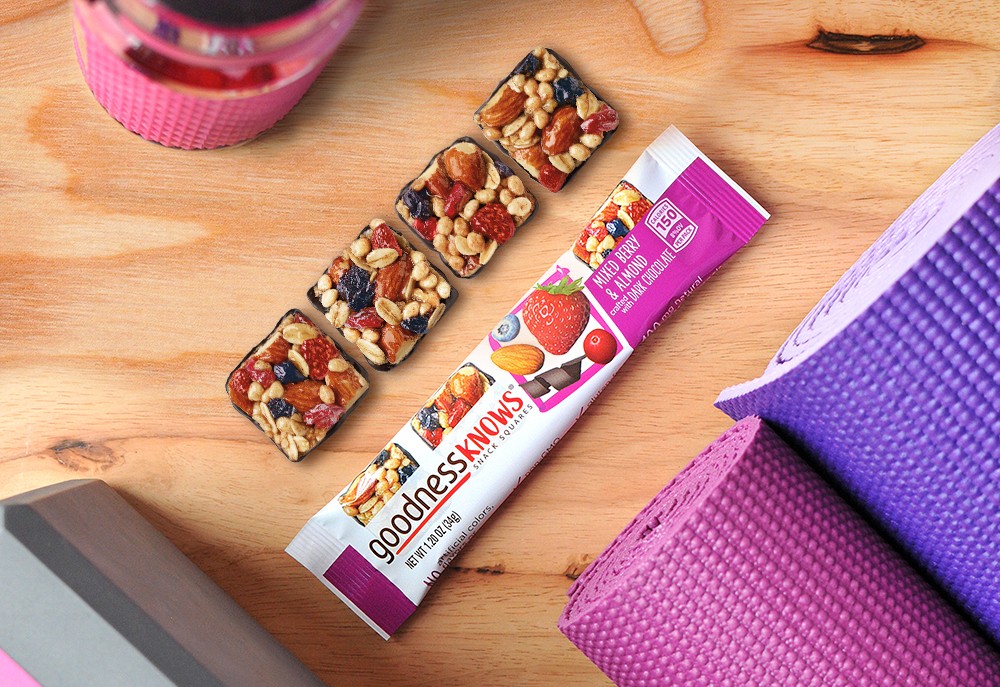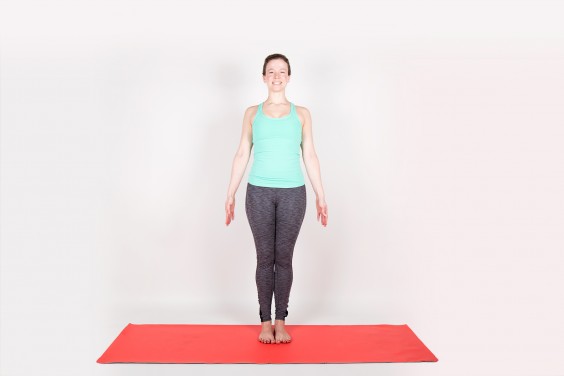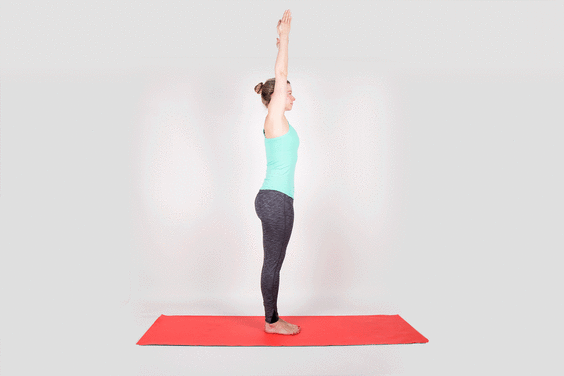Although it's an ancient practice, yoga has become the exercise du jour in recent years. Everyone from A-list celebs to your coworkers are getting their om on these days—and for good reason. Practicing yoga has serious health benefits, from boosting your immunity, helping you sleep better, fighting stress, and even improving your sex life.
YOU MIGHT ALSO LIKE 7 Yoga Moves for the Most Intense Muscle Burn Ever (Really!)READ
7 Yoga Moves for the Most Intense Muscle Burn Ever (Really!)READ
Plus, striking an impressive asana (yoga lingo for pose) looks ridiculously cool. The only problem? Sometimes it sounds like our yoga teacher is speaking in a different language, which makes it slightly difficult to follow along. With Sanksrit names like utkatasana and trikonasana, yoga poses may sound a lot more like spells you'd learn at Hogwarts than shapes you can actually get your body to make.
To help everyone from yoga newbies to experienced practitioners, we went to Chrissy Carter, a YogaWorks-certified yoga instructor, to help put together a definitive guide to yoga poses. Consider it your cheat sheet to finally mastering the common poses you're likely to encounter in most open-level classes.
Partner

Try Something Good
Each pack of goodnessKNOWS® snack squares comes with four bite-size bars, so you can share—or not. Real fruit (like actual cranberies, blueberries, and strawberries) and whole nuts make them chewy with just the right amount of crunch, while dark chocolate adds cocoa flavanols (that's the good stuff in dark chocolate). Try a little goodness for yourself: Use code 25GREATIST to get 25 percent off one box of your favorite flavor.*
*Save an additional 25% on one eligible item. Discount applies at checkout. Valid through July 11, 2017.
Basic Poses
1. Mountain
Tadasana
How to do it: Stand with feet together. Ground down evenly through feet and lift up through the crown of your head. Lift your thighs. Lengthen up through all four sides of your waist, elongating spine. Breathe easy.
The benefits: It may seem like you're, well, just standing there, but bear with us—this is the blueprint for all other poses. It promotes balance and directs your attention to the present moment.
2. Chair
Utkatasana
How to do it: Start in mountain pose. Raise arms and reach up through fingers. Sit back and down as if sitting into a chair. Shift weight toward heels, and lengthen up through torso.
The benefits: This heating standing pose (you'll feel the burn!) strengthens your legs, upper back, and shoulders.
3. Puppy Dog on Chair
Modified Downward Facing Dog
How to do it: Place hands on the back of a chair with palms shoulder-distance apart. Step feet back until they align under hips, creating a right angle with your body, spine parallel with the floor. Ground through feet and lift through thighs. Reach hips away from hands to lengthen the sides of your torso. Firm your outer arms in and lengthen through the crown of your head.
The benefits: Downward facing dog is the bread and butter of yoga, but it can be challenging for beginners. This modification shares the same benefits as the classic pose—stretching the hamstrings, opening the shoulders, and creating length in the spine—without all the weight on your upper body.
4. Downward Facing Dog
Adho Mukha Svanasana
How to do it: From all fours, walk hands one palm's length in front of you. Tuck toes and lift hips up and back to lengthen your spine. (If you're inflexible, keep your knees bent in order to bring your weight back into the legs.) Press into your hands, firm your outer arms, and reach your upper thighs back toward the wall behind you.
The benefits: This classic pose opens your shoulders, lengthens your spine, and stretches your hamstrings. Since your head is below your heart, the mild inversion creates a calming effect.
5. Warrior II
Virabhadrasana II
How to do it: Stand with feet wide, about 3 1/2 to 4 feet apart. Turn left foot in slightly, and turn right foot out 90 degrees to the side. Line up front heel with the arch of your back foot. Bend front knee to 90-degree angle, tracking the knee with the second toe to protect the knee joint. Stretch through your straight back leg and ground down into back foot. Reach arms out to shoulder height, shoulder blades down and palms wide, and gaze over the front fingers.
The benefits: A pose with "warrior" in its name may not sound very zen, but this standing pose can help calm and steady your mind. Tougher than it looks, it also strengthens your legs and ankles and increases stamina.
6. Triangle
Trikonasana
How to do it: Stand with feet wide apart. Turn left toes in slightly and rotate right thigh open until right toes point directly to the side. Keeping both legs straight, ground through your feet and pull your thighs up. Spread arms wide at shoulder height, roll your front thigh open and hinge at the front hip. Lengthen your spine toward the front foot and release bottom palm to the front ankle, a yoga block (placed outside the front ankle), or the seat of a chair.
The benefits: While this pose can be challenging for inflexible people, it will help promote balance, stretch the hamstrings and inner thighs, and create a feeling of expansion in the body.
7. Tree
Vrksasana
How to do it: Start in mountain pose. Bend one knee, using hand to bring foot into upper inner thigh. (If this feels difficult, bring the foot to the shin below the knee, or use the wall for balance.) Press into your standing foot, and lengthen up through the crown of your head.
The benefits: This pose helps improve concentration and your ability to balance by strengthening the arches of the feet and the outer hips.
8. Bridge
Setu Bandha Sarvangasana
How to do it: Lie faceup with knees bent, feet flat on the floor, and arms at sides. Keep feet parallel and hip-width apart, heels stacked under knees. Roll upper arms open to expand chest. Ground through outer upper arms, root down into heels, and reach knees forward to lift the hips off the floor. Shimmy your shoulders under your chest and interlace your fingers. (Hold onto the sides of your yoga mat to create more space if your shoulders are tight.)
The benefits: This energizing backbend opens your chest and stretches your neck and spine. It can calm the mind, reduce anxiety, and help improve digestion.
9. Bound Angle
Baddha Konasana
How to do it: Sitting on the floor, bend knees and open them wide like a book. Join the soles of your feet together while sitting upright. Place fingertips on the floor directly behind you and lengthen up through the entire spine. You can also hold onto ankles and hinge forward at hips. (Sit up on blankets if inner thighs are tight.)
The benefits: You'll give your inner thighs and groins a nice stretch, while the forward bend creates a calming, cooling effect.
10. Corpse
Savasana
How to do it: Lie faceup, separating legs and letting feet splay apart. Place arms along sides, palms facing up. Close eyes and relax.
The benefits: Yep, it's as simple as it sounds. Every yoga class includes a savasana, which relaxes the whole body and gives you space to absorb the benefits of the practice. Namaste.
Intermediate Poses
1. Plank
How to do it: Start in downward facing dog. Shift forward so your shoulders are stacked over wrists. Reach heels back as you lengthen the crown of your head forward. Ground down into hands, pull up through arms, and spread collarbones away from the sternum. Lift the front of your body up to support the pose.
The benefits: Considered one of the best moves for core strength, plank pose strengthens your abdominals and promotes stability.
2. Chaturanga Dandasana
How to do it: From plank pose, shift forward slightly. Bend elbows to a 90-degree angle with upper arms parallel to floor. Ground through palms and spread collarbones wide. Lift shoulders away from the floor as you pull your front ribs into the spine. Lift upper thighs toward the ceiling as you reach your tailbone toward your heels. Gaze forward.
The benefits: Chaturanga is a key part of sun salutations, which you’ll find in most vinyasa classes. It promotes core stability and strengthens your abdominals and triceps.
3. Upward Facing Dog
Urdhva Mukha Svanasana
How to do it: Lie facedown on the floor. Bend elbows and place hands on the mat in line with lower ribs. Reach back through your legs, and pull yourself forward and up to straight arms. Lift thighs and knees away from the floor, spread chest wide, and lift breastbone up.
The benefits: You'll open up your chest and shoulders, and stretch the abdominals and hip flexors. This pose appears after chaturanga in a classic sun salutation.
4. Half Moon
Ardha Chandrasana
How to do it: Start in triangle pose. Bend front knee, tracking it with your second toe. Step back foot in and walk bottom hand approximately 12 inches in front of you. Line up thumb with pinky toe. Shift your weight into front foot and lift back foot off the ground. Reach back leg strongly toward the wall behind you, then raise up top arm. To challenge your balance, rotate your chest up toward the ceiling and gaze up at your top hand.
The benefits: This balancing pose strengthens your legs and outer hips, stretches your hamstrings and inner thighs, and promotes concentration.
5. Warrior I
Virabhadrasana I
How to do it: Start in downward facing dog. Step one foot forward between your hands. Turn back foot out approximately 45 degrees and ground into back foot. Line up heel to heel, or slightly wider. Bend front knee over front ankle while you stretch through straight back leg. On an inhale, lift torso and arms up to the ceiling.
The benefits: This energizing pose strengthens your legs, arms, and back muscles. It also gives your chest, shoulders, neck, thighs, and ankles a nice stretch.
6. Warrior III
Virabhadrasana III
How to do it: From warrior I, hinge forward at the hips and rest your abdomen on your front thigh, arms alongside ears. Step back foot in and shift your weight into your front foot. Lift back thigh up and reach through back heel. Spin inner back thigh up to the ceiling. Press palms together and gaze forward at hands. (To modify, take arms alongside hips, or place hands on the floor or on blocks under shoulders.)
The benefits: This heating pose strengthens your legs, outer hips, and upper back. It also helps improve balance and posture.
7. Intense Side Stretch
Parsvottanasana
How to do it: Start in mountain pose. Step left foot back and place it flat on the floor at an approximately 45-degree angle. Ground down into both feet and lift up through both thighs. Lift arms up to shoulder height. Turn arms in slightly and join the palms to touch behind upper back. (To modify for tight shoulders, join fists to touch, grab opposite elbows, or place hands on the hips.) Hinge forward at your hips and lengthen spine over front leg. Lift shoulders away from the floor and spread chest wide.
The benefits: The pose helps calm the mind and stretches your spine, shoulders, wrists, hips, and hamstrings.
8. Dolphin
How to do it: Come to your forearms and interlace fingers, keeping elbows shoulder-width apart. Tuck toes, lift knees off the floor, and reach hips up and back. Allow head to hang off the floor. Ground down into forearms and lift shoulders away from the floor.
The benefits: This pose helps build strength in your upper body in preparation for headstand and forearmstand. It can also help calm your mind and relieve stress.
9. Bow
Dhanurasana
How to do it: Lie facedown, then lift chest, arms, and legs off the floor. Bend knees and reach back to grab outer ankles. Lift toes toward the ceiling, spin inner thighs in the same direction, and lengthen tailbone toward the backs of your knees. Spread and lift chest.
The benefits: This backbend stretches the whole front of the body, especially the chest and the fronts of your shoulders. It also gives a nice massage to your abdominal organs.
10. Camel
Ustrasana
How to do it: Kneel with shins hip-distance apart. Rest hands on the back of your pelvis. Press down strongly into shins and reach up through the torso. Lift chest up as you stretch arms back to reach hands to heels. (To modify, curl toes under so you don’t have to reach as far.)
The benefits: This backbend stretches the entire front of your body, from your throat to your ankle, and even helps strengthen back muscles.




















No comments:
Post a Comment